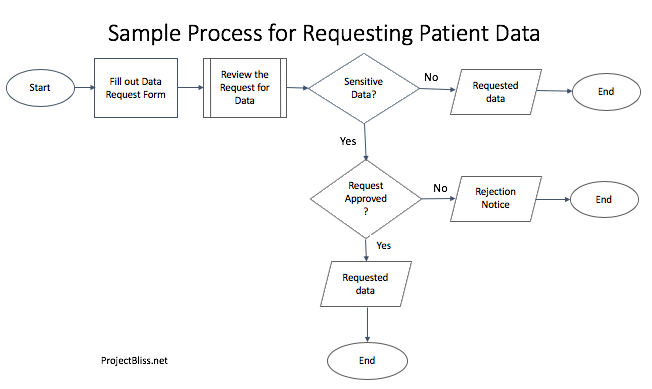If you’ve been asked to complete a business process map it may feel overwhelming. You may have an idea of what that is, but you want to be sure you do it right.
It’s not intuitive at first, but once you learn how, it’s much easier than you think.
And k
Once I learned how to create business process maps I used them a lot. I created project process documents for my development team – even without knowing how to write code! I was able to draft process maps to communicate across teams. And I created process maps for governance, and even for team process documentation.
And it’s a great tool when you want to identify process improvement opportunities.
I’m going to show you how to create business process maps so you’ll be able to apply this skill in your work.
This is a skill that’s super valuable to you as a project manager, and you’ll use it in many different situations.
And this is a skill you can use whether your team uses waterfall or Agile or something in between.
What is a Business Process Map?
A business process map is a visual depiction of the series of steps – and any additional information you wish to include – involved in carrying out a process.
You lay out the actions needed to carry out the process. You can also include varying amounts of information, depending on what you need.
Some people refer to these drawings as
This drawing shows you visually how work flows through multiple steps.
Why Create a Business Process Map?
These workflow diagrams give you and others a way to see all the work involved from beginning to end of a specified process.
This is important if you want to make improvements or changes to your current way of working.
You first have to know your baseline or current state.
If you want to know where to make improvements, a business process map can give you visibility to the process so it can be improved.

When to Create a Business Process Map
The following situations are times when creating a process map can be valuable:
- Creating a new solution for a user and need to understand current state processes.
- Making a change to an existing solution and need to establish current state processes.
- Looking for improvement opportunities to increase efficiency.
- Looking for gaps, bottlenecks, redundancies, or waste in a current process.
- Establishing standard practices that need to be documented.
- Seeking clarity about a current process for more detail.
- Communicating to others information about your processes.
Process maps are useful because they give a picture of how work is done. They’re easier to read than large blocks of text. And they facilitate discussion during problem-solving sessions.
As you can see, there are many instances where a well-documented process flow can be helpful.
And to build a process flowchart, you don’t have to be an expert on the process. You can facilitate discussion with those who are the experts and create the flowchart from the information they give you.
Process maps are a particularly good tool because they…
- are easy and inexpensive to build.
- foster communication and understanding across team members working together to create them.
- show clear steps and detail involved in a process for easier understanding.
- can help isolate problems for improved problem-solving.
- can be as simple or complex as needed.
And in today’s marketplace, process improvement is important for improving efficiency and better performance. ISO 9001:2015 provides criteria for quality management and includes a focus on process and continual improvement. If your organization follows ISO 9000 quality management standards, process mapping will be a useful skill.

How to Create a Business Process Map
1. Decide what information you need to include in your document. There are many types of information you could include. Again, no need to add more than is necessary. Review the list, discuss with your team, and determine which data components to include.
Here are different types of information you could include in your process map:
- Data
- Users
- Steps
- Actions
- Tools – software applications
- Key Performance Indicators telling how success is measured
- Policies or Compliance Requirements
- Physical location
2. Determine the boundaries
3. List the actions included in the process. Start from your starting point and include all the actions between the start and stop. Do this with the people that carry out these steps. You may not have them all in the right order at first.
4. Put these steps in sequential order, from beginning to end.
5. Use shapes to create a visual representation of the process. This will create your process flow map.
Use the following shapes to represent the components of your process:
- Oval is start and end
- Rectangle is actions
- Diamond is the decision point
- Arrows connect the actions and tell how to move forward between the actions.

6. Indicate if the process starts over anywhere. If the process is cyclical and starts over, make sure you have an arrow that points back to where the process resumes. You don’t want to keep an open end to the process. It should have a defined end point or circle back to a point in the process loop.
7. Add other details. Add in other detail you want to include in your process flow. Be consistent throughout the process map. For example, if you’re providing the role who completes each step, do it for all actions and not only a few.
8. Get feedback. Have those who are familiar with the process review the document. Get feedback and input on the diagram you’ve created.
9. Make adjustments where needed. Make changes and adjustments where needed to reflect the actual process.
10. Name and date your document. You’ll likely refer to the document in the future and you’ll want to know when it was created.
Best Practices
- Involve the people who carry out or have a role in the process you’re documenting. They know it best and are the experts.
- Don’t try to include every exception. You likely can’t capture these.
- Document your “as-is” state before you start making changes to your processes.
- Determine the goals and which process map style best fits your need. There’s no need to create a document that provides way more information than you need.
- Determine your audience and what you’ll use it for and choose the style that best fits.

Tools
Sticky notes work great if you’re starting from scratch on a process you need to get organized as a group – especially if the process is confusing. You can write the process steps on sticky notes and put them on a whiteboard, and draw arrows between them and move them around as needed
Here are some electronic options you may want to try
- Visio – Part of the Microsoft Office suite
- PowerPoint – Not designed specifically for process mapping, limited symbols.
- Lucid Chart
- Smartsheet – Collaborators can view, edit, and add to sheets for free
Smartdraw – Economical- yEd – Free process mapping tool
You can create your business process map on sticky notes, on a white board, on with electronic tools. The most important things is that everyone can easily participate and work with it. If you do create it with post-it notes or a white board, make sure to document it somewhere more permanent!
Summary
Business Process Maps can be created in many different situations where teams want to make changes or communicate current processes to others. Knowing how to create a business process map is a skill that project managers can rely on to provide value to teams and organizations.
It doesn’t have to be intimidating or overwhelming. Just follow the steps and turn to those who know what activities and information are involved.
You don’t have to know the process you’re documenting to be able to create a great process map. The best process maps are created as a group activity.
SIPOCs are one type of process documentation you may find useful when you need a lot of detail about a process. Learn exactly how to create a SIPOC model in this post – template included:
How to Create a SIPOC Model for Process Creation or Improvement [SIPOC Template Download]



No Responses